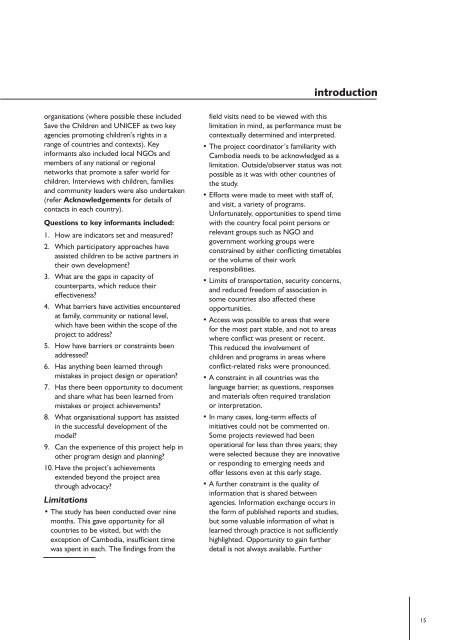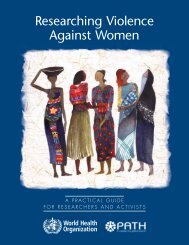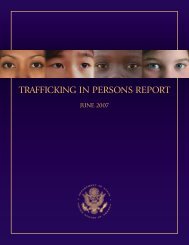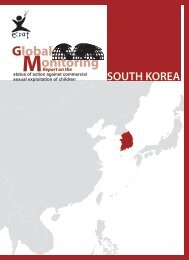Download PDF - Violence Against Children - East Asia and the ...
Download PDF - Violence Against Children - East Asia and the ...
Download PDF - Violence Against Children - East Asia and the ...
You also want an ePaper? Increase the reach of your titles
YUMPU automatically turns print PDFs into web optimized ePapers that Google loves.
introduction<br />
organisations (where possible <strong>the</strong>se included<br />
Save <strong>the</strong> <strong>Children</strong> <strong>and</strong> UNICEF as two key<br />
agencies promoting children’s rights in a<br />
range of countries <strong>and</strong> contexts). Key<br />
informants also included local NGOs <strong>and</strong><br />
members of any national or regional<br />
networks that promote a safer world for<br />
children. Interviews with children, families<br />
<strong>and</strong> community leaders were also undertaken<br />
(refer Acknowledgements for details of<br />
contacts in each country).<br />
Questions to key informants included:<br />
1. How are indicators set <strong>and</strong> measured?<br />
2. Which participatory approaches have<br />
assisted children to be active partners in<br />
<strong>the</strong>ir own development?<br />
3. What are <strong>the</strong> gaps in capacity of<br />
counterparts, which reduce <strong>the</strong>ir<br />
effectiveness?<br />
4. What barriers have activities encountered<br />
at family, community or national level,<br />
which have been within <strong>the</strong> scope of <strong>the</strong><br />
project to address?<br />
5. How have barriers or constraints been<br />
addressed?<br />
6. Has anything been learned through<br />
mistakes in project design or operation?<br />
7. Has <strong>the</strong>re been opportunity to document<br />
<strong>and</strong> share what has been learned from<br />
mistakes or project achievements?<br />
8. What organisational support has assisted<br />
in <strong>the</strong> successful development of <strong>the</strong><br />
model?<br />
9. Can <strong>the</strong> experience of this project help in<br />
o<strong>the</strong>r program design <strong>and</strong> planning?<br />
10. Have <strong>the</strong> project’s achievements<br />
extended beyond <strong>the</strong> project area<br />
through advocacy?<br />
Limitations<br />
• The study has been conducted over nine<br />
months. This gave opportunity for all<br />
countries to be visited, but with <strong>the</strong><br />
exception of Cambodia, insufficient time<br />
was spent in each. The findings from <strong>the</strong><br />
field visits need to be viewed with this<br />
limitation in mind, as performance must be<br />
contextually determined <strong>and</strong> interpreted.<br />
• The project coordinator’s familiarity with<br />
Cambodia needs to be acknowledged as a<br />
limitation. Outside/observer status was not<br />
possible as it was with o<strong>the</strong>r countries of<br />
<strong>the</strong> study.<br />
• Efforts were made to meet with staff of,<br />
<strong>and</strong> visit, a variety of programs.<br />
Unfortunately, opportunities to spend time<br />
with <strong>the</strong> country focal point persons or<br />
relevant groups such as NGO <strong>and</strong><br />
government working groups were<br />
constrained by ei<strong>the</strong>r conflicting timetables<br />
or <strong>the</strong> volume of <strong>the</strong>ir work<br />
responsibilities.<br />
• Limits of transportation, security concerns,<br />
<strong>and</strong> reduced freedom of association in<br />
some countries also affected <strong>the</strong>se<br />
opportunities.<br />
• Access was possible to areas that were<br />
for <strong>the</strong> most part stable, <strong>and</strong> not to areas<br />
where conflict was present or recent.<br />
This reduced <strong>the</strong> involvement of<br />
children <strong>and</strong> programs in areas where<br />
conflict-related risks were pronounced.<br />
• A constraint in all countries was <strong>the</strong><br />
language barrier, as questions, responses<br />
<strong>and</strong> materials often required translation<br />
or interpretation.<br />
• In many cases, long-term effects of<br />
initiatives could not be commented on.<br />
Some projects reviewed had been<br />
operational for less than three years; <strong>the</strong>y<br />
were selected because <strong>the</strong>y are innovative<br />
or responding to emerging needs <strong>and</strong><br />
offer lessons even at this early stage.<br />
• A fur<strong>the</strong>r constraint is <strong>the</strong> quality of<br />
information that is shared between<br />
agencies. Information exchange occurs in<br />
<strong>the</strong> form of published reports <strong>and</strong> studies,<br />
but some valuable information of what is<br />
learned through practice is not sufficiently<br />
highlighted. Opportunity to gain fur<strong>the</strong>r<br />
detail is not always available. Fur<strong>the</strong>r<br />
15

















